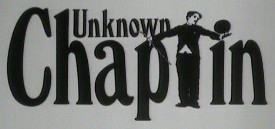
It’s not for nothing that silent-film historian Kevin Brownlow has been regarded as a demi-god among Hollywood buffs and received an honorary Oscar in 2011. And if he, along with partner David Gill, had accomplished nothing in his life but Unknown Chaplin, Brownlow would have more than earned his accolades. Acid test for Chaplin buffs: Watch just the first two-and-a-half minutes of the first segment, and see if you’re not moved to tears.
This is an extraordinary silent-film documentary that, by rights, shouldn’t have existed in any form. Like a master magician, Chaplin was secretive about the tricks of his trade, and it was believed that he had destroyed all unused footage from his films. Happily, this documentary proves us wrong – and all the richer for it.
Besides providing eye-popping footage that shows, in a wildly different light, films we thought we’d endlessly seen and known, Unknown Chaplin clearly demonstrated Chaplin’s working method: that of “rehearsing on film,” as it’s described by actor James Mason (who does a lovely job of narration throughout). Time after time, we see Chaplin fleshing out a germ of an idea – sometimes to full fruition, other times to heartbreaking pointlessness and deletion from the final film.
The documentary also makes clear that Chaplin didn’t care how much time and money he spent to get things right. The “suits” at Mutual and First National often had to be placated when it seemed as though Chaplin was blowing their budgets to no result, but when Chaplin became his own producer at United Artists, his behavior was the same, putting his money where his mouth was in order to achieve a quality film.
Unknown Chaplin is divided into three 50-minute segments. The first, “My Happiest Years” (Chaplin’s description of his 1916-17 period with Mutual Film), uses generous clips to detail the origins of many of his Mutual shorts. The Immigrant, for example, began as a simple comedy of manners set in a small café, with Chaplin trying to impress Edna Purviance, and Chaplin’s long-time associate Henry Bergman played a not-very-assertive waiter. After much trial and error, Bergman was replaced by the far more intimidating Eric Campbell, and Chaplin stumbled upon a valid reason for Purviance’s appearance: she and Charlie had just come to America as immigrants. Several other examples show Chaplin grinding away to no apparent purpose, only to come upon a perfect excuse for risible comedy.
The second segment, “The Great Director,” features generous interviews with several of Chaplin’s co-stars, such as Jackie Coogan (the kid from the same-named movie) and The Gold Rush’s Georgia Hale (who makes it abundantly clear that the romance she portrayed with Chaplin wasn’t just acting). The bulk of the segment is devoted to City Lights, with Chaplin frustrated by Virginia Cherrill’s initially limp acting as the blind flower girl (Cherrill, interviewed here, offers no ill will towards Chaplin), and Chaplin’s desperation to derive a plausible reason why the blind flower girl would think the Tramp is a rich man (Solution: The Tramp, eluding a cop, slipped through the door of a real rich man’s limo and thereupon met the flower girl).
For me, the weakest segment is the final one, “Hidden Treasures.” The first half is mesmerizing, as it demonstrates how Chaplin would do casual comedy routines, such as at parties, that later turned up in his movies. The segment also shows a fascinating fragment from a never-completed Chaplin film, The Professor, in which he was to play a run-down stage performer with a flea-circus act (some of which Chaplin later incorporated into his feature film Limelight).
On the other hand, the segment also shows scenes which make perfectly clear why Chaplin deleted them. There’s a very lengthy passage that was to have been in The Circus (part of it even involving split-screen special effects) in which a jealous Charlie tries to prove himself superior to the circus’ high-wire man. The movie as is states the theme and then moves on briskly; this protracted segment would have slowed the film and, frankly, doesn’t even make sense on its own terms. (At one point, Charlie is clearly irritated when a stranger in a restaurant bullies and pesters him; yet shortly thereafter, Charlie befriends the man to suit his own purposes. Huh?) Similarly, deleted scenes from City Lights and Modern Times provide a big build-up to a small pay-off.
But these scenes are hardly enough reason to discourage any Chaplin buff from indulging in this lovingly produced documentary. It’s as though Chaplin left one more remnant of film behind, just for some close friends.
Click here to return to:
HomepageFilmography